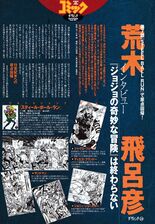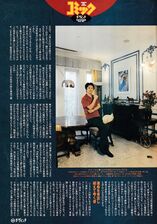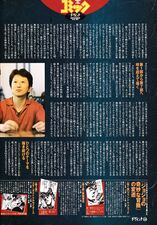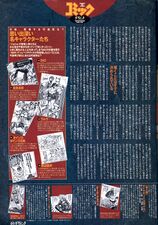Da Vinci (August 2005)
Quarterly S (June 2005)
Interview Archive
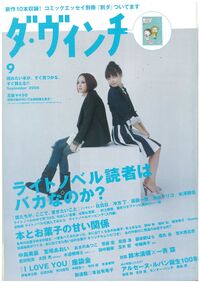
An interview with Hirohiko Araki at his house, published in the September 2005 issue of Da Vinci magazine.[1]
Interview
Returning to the starting point with Part 7: Steel Ball Run!
Araki Hirohiko
Interview
JoJo's Bizarre Adventure is not over
Steel Ball Run, Part 7 of the long-running comic JoJo's Bizarre Adventure, which began serialization in Weekly Shonen Jump in 1986 and currently moved to Ultra Jump, continues the story of the JoJo lineage and destiny even today. However, the setting overlaps with the same time period as Part 1, the end of the 19th century. Of course, JoJo, Dio as well as Stand abilities make an appearance. Is this a parallel world, and will we also return to the starting point of their lineage? SBR, which is said to be conscious of the culmination of his hard work, is bursting with dynamic vitality and also appears to rapidly become a masterpiece!
Interview/Text from Akira Odera / Pictures from Munemichi Kawaguchi / © Hirohiko Araki/Shueisha
You probably know that the serialization of JoJo’s Bizarre Adventure (JoJo), which illustrates a bloodline that was enthralled by fate, is still running today. It started serialization from 1986 onwards and was continually written under the title JoJo’s Bizarre Adventure until Part 6: Stone Ocean. However, the JoJo series is now entering a new phase. First off, the title was changed to Steel Ball Run (SBR). Additionally, the period setting has become the end of the 19th century, just like when Part 1 was first serialized. Does this mean that time has come full circle, and that the series starts again from zero after breaking into a parallel world due to the shocking ending of Part 6? Or is this story connected to the story of the Joestar family in a loop? In this new world both JoJo and Dio make an appearance, Zeppeli is a semi-main character (in Part 1, a character named Baron Zeppeli appeared), and deeply familiar names reappear. Furthermore, the serialization moved from Weekly Shonen Jump to the monthly magazine Ultra Jump. It appears as though SBR becomes a break in the JoJo series in various aspects. The family tree which was present in the comic’s opening page has disappeared since SBR, but the story is still a story about JoJo. What does the author Araki Hirohiko have in mind for the new developments in the JoJo series? One thing that we know for certain is his clear determination to not let JoJo come to an end.
In a western-style house that appears as if it materializes the drawn world of JoJo, we began our interview surrounding a marble round table. The owner of the house is just as cheerful and energetic as a young boy. First off, I asked him about what the true intention of once again returning to the setting of the end of the 19th century in Part 7: Steel Ball Run is.
Araki: I had the feeling of wanting to try returning to the starting point. I deliberately kept the stand abilities simple so that the suspense and human drama could be seen clearly. I was also thinking about the readers who hadn’t read JoJo until now. I didn’t want to suddenly bring out a Stand (the visualization of a supernatural power), I wanted to develop them so that they could be understood from the ground up. Maybe the reason why I returned back in time to the end of the 19th century again is meant to be a culmination of my own work. However, in the sense of being a parallel world, fates overlap in this world as well. After all, Johnny Joestar’s rival is Dio, and I draw with such symbolism in mind. People who have read JoJo up to this point will understand this.
In SBR, he illustrated an epic race across the North American continent on horseback. It appears that we return once again to an adventure that overflows with a dynamic wilderness, and it is a work we look forward to the developments of. Mr. Araki said that there is a special emotional attachment to the image of a man on a horse riding through the desert to him, which is depicted in SBR.
Araki: When I was a child, the very first movie my father was taking me along to see was Clint Eastwood’s For a Few Dollars More, which is my starting point. I didn’t get the story at all, but the image of a lonely man riding on a horse in the desert is strongly burned into my mind. I watched it again at the time of drawing SBR, and it has an almost mythical, symbolic composition, doesn’t it?
According to Mr. Araki, the time period of the end of the 19th century was also the era of an extremely special turning point in the history of mankind.
Araki: I have the feeling that it’s an “era of beginnings” comparable to the renaissance era. In the U.S., the telephone was invented and spread with a single swoop. In terms of fine arts, post-impressionism emerged in France, as well as Picasso. In Japan, the Meiji Restauration started. I believe there was a single gigantic stream all over the world. It was also an era of an explosive increase in population. I get the sense that all kinds of things have their roots in that era, and that the fate that humans have inherited from generation to generation were also condensed in that era as “beginnings”.
There are developments as if there would be another big bang, the way the universe contracted, having entirely expanded to its limits. Individual stories center suspense and battle tactics, but when you take an extensive view at the JoJo series as a whole, its grand concept makes you feel like you’re reading the latest cosmology or Indian philosophy.
The fundamental themes of JoJo are “fate” and “destiny”. It seems that by entering a parallel world in SBR, the theme of “destiny” will no longer rise to the surface through bloodlines, but through other aspects from here on out. I asked Mr. Araki about his view on destiny that he attempts to illustrate.
Araki: The theme of JoJo is to accept and face one’s ancestral fate. I wanted to draw people who don’t indecisively curse their own destiny or try to change it, but instead attempt to surpass it.
Whenever I read JoJo, I get the feeling like my spine is straightened when people keep being portrayed who, although seemingly being at the mercy of one’s destiny, affirm it and are prepared for their deaths. Even if they are villains, they all somehow have their own way of living and philosophy, and they have the strong force of will to defy their destiny.
Araki: From today’s psychiatric point of view, the serial killer Yoshikage Kira who appears in Part 4 is probably a victim of abuse from his parents or something similar, and most likely developed such a personality unwillingly. But I don’t want to portray villains in such a way. He is certainly a murderer, but he affirms that about himself and lives after his own theories.
From the viewpoint of strength, Mr. Araki says he feels such characters are stronger and scarier. Mr. Araki illustrates a „strength” that doesn’t stick to simple good and evil.
Araki: Not going into the direction of a spiritual deficit is the basis of shonen manga. For example, I didn’t really like a manga that seemed to dwell on the question on why someone became a cyborg. It’s not exactly refreshing. I thought that it would be better if they got used to and lived with their fate. I wanted to portray that even if there is a fight, it is a fight in which two characters clash and the spirits of both develop higher and higher, step by step.
All the characters that appear in JoJo are fascinating. Speaking of Dio and Yoshikage Kira, the villains also all have their own beliefs and rules they live by. Then, what did Mr. Araki say about his rules when he’s drawing manga?
Araki: The rule in my mind is that it’s all humans, down to the last. They don’t get something like a powerful mecha or a sword to defeat an enemy. They win by their own emotional and physical strength entirely. However, I have little faith in willpower. Even if strength is suddenly brought out and the odds are surprisingly turned around, if there is no theory behind that, it can’t be convincing. Also, there can’t be negative thinking. Both villains and humane people live affirmative to the way of life they follow.
That is the overarching theme of JoJo, “an ode to humanity”. Even if fate can’t be changed, one lives on without being disheartened. The straightforward spirituality one feels in JoJo is probably due to this unwavering theme.
Still, even though I have been reading JoJo since it was first serialized, I never would have imagined that it would continue to a total of 85 volumes. Looking back once more, what does Mr. Araki think about having continued until now? I asked him about the resulting changes from Part 1 to Part 7: Steel Ball Run.
Araki: About how the title of JoJo came around, that’s because at the time, we often used a family restaurant called Jonathan’s for my briefing sessions. At the start, I was conscious of the relationship between grandfather and grandson. At the time, I was greatly moved by the novel East of Eden and the movie The Godfather, and I thought that I wanted to draw such works as well. At the beginning of the serialization, Fist of the North Star and Schwarzenegger movies were popular, and under that influence, the story was about physical pursuits. Part 2 is still an extension of that as well. But while I was drawing physical fights, I came to understand that it was all about the mind and shifted to mental battles.
So from Part 3 onwards, Stands make an appearance, which hold the key to winning or losing in a game of real heart and witful tactics. Owing to the appearance of Stands, it broke free of the macho-like fighting manga formula, and numerous named characters were created which could be called non-physical, like Oingo, Boingo and Rohan Kishibe.
Araki: The truth is, I planned to conclude the series in Part 3, where the connection with Dio spanning three generations would be settled. But because Part 3 had a road trip movie-like story, there were only attack-type Stands, and I wasn’t able to use the idea of a spider-web type of stand. Because I had a lot of ideas left over for such Stands, I established a town as the setting and started on Part 4.
The setting of Part 4 became Morioh, a fictional town. He drew up a detailed town map, down to deciding on the names of the stores, and thoroughly focused on placing the appearing characters as if they really existed in the town. Mr. Araki says that he wanted to depict daily life there.
Araki: Morioh was made in the image of Sendai, the town I was born in, and around the time when I was a child, it was still surrounded by hills and fields. But during the bubble economy of the 1980’s, the hills were cut down and commuter towns were built. I thought things like if it was fine in a religious sense, as temple towns were also torn down. Beautiful houses and mansions were built en masse, but the people who lived there were all strangers, and in the eyes of the residents who lived here since long ago, that was a bit eerie. There were a lot of things like rumors about ghosts coming out. When I hear those stories, I automatically imagine that there’s something behind them, and that became the image of Morioh.
Furthermore, in Part 5, the setting shifts to Italy, where Mr. Araki had travelled more than 15 times, and portrays a group drama of gangsters. In Part 6, the first female protagonist was depicted. Having come this far, one gets wrapped up in the strange feeling as if continuing to draw JoJo is now Mr. Arakis destiny.
Araki: I had no choice but to set Part 6 in the near future of 2011, as around the time of Part 3 being drawn, it already overlapped with the present. I don’t want to draw the distant future. After all, I want the feeling of a present-day car driving around and things like that.
And in SBR, we return once again to the starting point and begin at the end of the 19th century. Making the utmost of the special characteristics of manga which allow for free expression, Mr. Araki even exceeded time.
Araki: I didn’t think that I’d continue until now, but I believe that I’d keep pursuing the themes depicted in JoJo. It feels like destiny, and the time passed so quickly. Whichever author it is, I think they have one or two masterpieces. Even if you’re reading Mr. Osamu Tezuka as a single stream, you get the feeling that a theme continues in all of his works. I am also conscious of the image of manga that seems like a collection of short stories which form a large river.
In the JoJo series, Mr. Araki was first focused on the relationship between grandfather and grandson. This seems to give the impression of Mr. Araki himself having been a “grandfather’s boy”. What kind of boyhood did Mr. Araki have?
Araki: I had two younger twin sisters. Our parents most likely loved us evenly, but my twin sisters woke up at the same time, went to school together, wore the same clothes and so on. That’s why I had the feeling that I alone was left out, and always went to my grandfather’s place to play. There, I came in touch with manga, movies, and art, and my solitude was alleviated. My grandfather made things like models and kites for me, and regardless of what he made, he enjoyed making it.
In such a boyhood, Mr. Araki started drawing manga. Surely, his grandfather who enjoyed making things was an influence. Likewise, the painter Gauguin is one of Mr. Araki’s most influential figures. He was not only influential in his expressions, but also in his way of life.
Araki: When I heard that he lived on a seemingly uninhabited island in Tahiti only for the sake of painting pictures, I received a great shock when it came to my understanding of art until then, and my perception of things changed. I reached the point of looking deeper into the backside. There are people who paint skillfully in many fields too, but knowing Gauguin’s way of life, I also somehow came to think that I wanted to pursue a single thing.
This is what must have led Mr. Araki to continue drawing the single grand story of JoJo. Unless there are dramatic changes, Mr. Araki told us he intends to continue drawing JoJo for as long as he lives.
When Mr. Araki thinks about the story, he says that he begins by meticulously making a map of the city and blueprints for rooms. Aside from that, as far as important characters are concerned, he draws up their personal histories, which include everything to a brief personal record of their parents. Furthermore, if the setting is overseas, he says that before he starts to draw, he actually travels there for research and gets a sense of not only the atmosphere of the city, but also on the location of the streets and the distances between them.
Araki: I want to understand where on the globe the protagonist is. If you don’t know where on earths latitude and longitude they are and what surrounds them, you don’t get to understand in which way the appearing characters will act.
He laughs and talks like that, but I once again feel the depth of JoJo. One is made to feel like the ego of each individual appearing character almost really lives and breathes in that world; that is the charm of JoJo. And Mr. Araki lets me hear an even more interesting story.
Araki: The sculptor Michelangelo said that just by looking at the stone, he already decided on the shape he was going to cut it into. When I heard that story, even though I should be able to carve anything, I felt it was destiny that I could carve nothing but one shape.
Mr. Araki says that he feels the same way even when drawing manga.
Araki: For example, when the protagonist is currently in Aoyama and decides on where to go next, even when he can go to Shinjuku, Tokyo, or Nagoya by train, if you decide on their personality, regardless of the myriad of choices available, it becomes so that they have no other choice but to go to Shinjuku. The author also can’t help it. If you unreasonably try to force the story to go into a more convenient direction, it will become inconsistent and automatically collapse. I feel a sense of destiny there when I draw. I understand the meaning of what Michelangelo said by drawing manga.
Even though you should be able to draw everything, it had already been decided. The strangeness and sublimity of destiny portrayed in JoJo may not even be under the author’s control. This is why one could say that he was able to draw (or was made to draw) a story that stands out to this extent in the history of manga. Mr. Araki draws manga in an extraordinary domain. When Mr. Araki is drawing manga, what time is the most exciting moment?
Araki: After all, the most fun is when I draw something that no one else has done before. This already has no more relation to being popular or some such. I have the feeling that about everyone can pull this off.
I definitely have the premonition that in SBR, something unexpectable is being drawn.
[Translated by Aiku (JoJo's Bizarre Encyclopedia)]
